2019/10/10 ドイツ連邦共和国ミュンヘン工科大学 (TUM)

・ TUM は、直径 1 インチ(約 2,5cm)ほどの 6 角形のセルからなる人工スキンを開発。それぞれのセルが、触感、加速度、接近度、温度を検出するマイクロプロセッサーとセンサーを搭載。ロボットが周囲の環境をさらに詳細に高感度で感知でき、人間の近くで作動する際の安全性の向上と事故の回避につながる。
・ 同スキンセルは、10 年前に TUM の認知システムを研究する Gordon Cheng 教授が開発。今回、高度なシステムへの統合でその可能性をフルに発揮。
・ ロボットスキン開発における最大の課題は、その演算処理能力。人工スキンのセンサーからのデータ処理を継続的に実行すればすぐに限界に達し、従来のシステムでは、僅か数百個のセンサーのデータは直ちに過重負荷となる。
・ この課題を解決するため、神経エンジニアリング(NeuroEngineering)のアプローチを採用し、スキンセルのモニタリングを継続的ではなく、イベントベース型のシステムで対処。これにより、演算処理の負荷を 90%低減した。
・ これは、帽子を頭に乗せた瞬間にはそれ感知するが、すぐに慣れて行く人間の神経システムの働きのように、個々のセルは、値が変わった場合にのみセンサーから情報を送信する。
・ このようなイベントベース型のアプローチで、人間サイズの自律型ロボット「H-1 ロボット」に同人工スキンを適用。外部演算処理が不要となり、同ロボットの上半身、腕、足や足の裏に配置された 1,260 個のセルと 13,000 個を超えるセンサーが、床面の歪みの感知や、一本足でバランスをとる等の新しい「体感」を付与する。
・ 同人工スキンにより、ロボットは安全に人間を抱き込むことができる。その際、互いの身体の様々な部分が接触するが、同ロボットはこの複雑な情報から適切な挙動を計算し、正確な接触圧を実行。介護分野等の、ロボットが人間に密着した動作が求められるような場合に有効。
・ 同ロボットスキンは、強靭で多用途。1 種類の材料ではなくセルで構成されるため、数個のセルが作動停止しても機能性を維持。様々なロボットにトラブルフリーですぐに使用可能なシステムと考える。現在、より小型の大量生産可能なセルを開発中。
・ 本研究は、German Research Foundation (DFG) の large equipment grant application より資金を得た。
URL: https://www.tum.de/nc/en/about-tum/news/press-releases/details/35732
(関連情報)
Proceedings of the IEEE 掲載論文(フルテキスト)
A Comprehensive Realization of Robot Skin: Sensors, Sensing, Control, and Applications
URL: https://ieeexplore.ieee.org/document/8812712
(関連情報)
IEEE Robotics and Automation Letters 掲載論文(アブストラクトのみ:全文は有料)
Evaluation of a Large Scale Event Driven Robot Skin
URL: https://ieeexplore.ieee.org/document/8769940
(関連情報)
IEEE Robotics and Automation Letters 掲載論文(アブストラクトのみ:全文は有料)
Pressure-Driven Body Compliance Using Robot Skin
URL: https://ieeexplore.ieee.org/document/8760400
<NEDO海外技術情報より>
Biologically-inspired artificial skin improves sensory ability of robotsSensitive robots are safer
Sensitive synthetic skin enables robots to sense their own bodies and surroundings – a crucial capability if they are to be in close contact with people. Inspired by human skin, a team at the Technical University of Munich (TUM) has developed a system combining artificial skin with control algorithms and used it to create the first autonomous humanoid robot with full-body artificial skin.
The artificial skin developed by Prof. Gordon Cheng and his team consists of hexagonal cells about the size of a two-euro coin (i.e. about one inch in diameter). Each is equipped with a microprocessor and sensors to detect contact, acceleration, proximity and temperature. Such artificial skin enables robots to perceive their surroundings in much greater detail and with more sensitivity. This not only helps them to move safely. It also makes them safer when operating near people and gives them the ability to anticipate and actively avoid accidents.
The skin cells themselves were developed around 10 years ago by Gordon Cheng, Professor of Cognitive Systems at TUM. But this invention only revealed its full potential when integrated into a sophisticated system as described in the latest issue of the journal “Proceedings of the IEEE”



